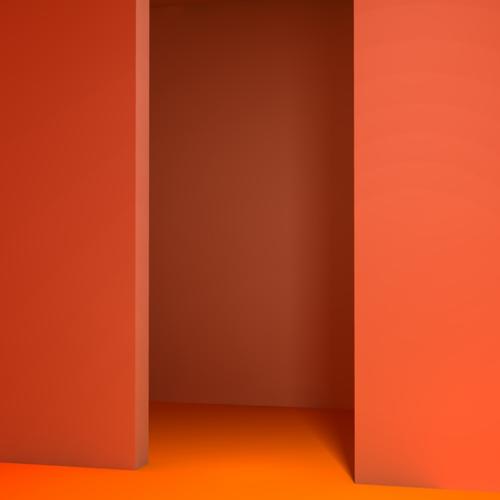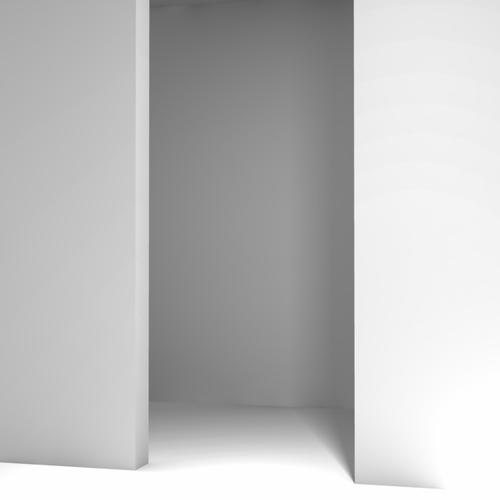Indirect light in closed room
 Elele
Posts: 1,097
Elele
Posts: 1,097
Hello,
I got a simple white room with a spot light and indirect lighting (see pic).
When I give the floor in this room a simple color, the whole room get colored with indirect light (see pic). Is there a way to keep the indirect light, but not have it so colored?
Thanks,
Elele.


2.jpg
650 x 650 - 61K


1.jpg
650 x 650 - 46K


Comments
I've always thought that color bleed seems excessive in Carrara but it never occurred to me to do such a simple experiment. That does look pretty bad.
Things to try:
reduce the saturation of the colored surface (real life has no such equivilent as 100% saturated color)
Add an subtle ambient color that counter balances it (opposite color on the wheel)
Use shadow buffer lights with shadows turned down to 60% so they act as fake bounce light (watch out for transparent textures)
Turn down the GI to 40%
Carrara is an art tool, not a physics emulator. Does you scene have a white ceiling to bounce white light back into the scene?
Seems to me that the purpose of Indirect Light is to provide a (cheap) approximation of real world behavior. It also seems clear that it could be doing a better job.
There's no need to get defensive. This feature could be better ≠ Carrara sucks.
Thanks for the replies :)
There is a white ceiling and the room is completely closed.
Making the color less saturated actually makes things worse, seems carrara adds saturation with each bounce.
Here's an example with the floor 255 240 255 (light purple). There room gets a lot more purple than the original floor color.
To what should i apply the ambient color? To the light?
I don't really want to add other lights to fake IL, caus I might as well just fake the IL then.
Also added a screeny with the render settings.
Also added a screeny of the scene, to show it really is only the floor that is colored :D
That is totally bizarre. I've had some great results with GI. I see your render settings, which look fine. How do you have your lights and ambient lighting set up? With Indirect Lighting (Full GI) I think you want the ambient lighting set to 0, where you actually want it up higher than default when using ambient occlusion. Not sure if that will help.
Also what color are your "white" walls and how shiny are your surfaces - this also has an impact.
The shaders are just plain colors with everything else turned off and a spot light (see pics).
BTW, I don't want to complain about Carrara or "attack" anything. Sorry if it comes over like that. I'd just like to know if there's a way to fix this without faking the IL. I like the IL in Carrara a lot, but i can't get it to work in closed rooms :(.
Also Studio has the same problem :D. I haven't tried in Poser but it probably has the same issue...
As far as i know at least, the problem is the closed room, but i could be wrong. Added a pic with the ceiling removed (creating an "open" room), wich looks much better IMHO. I also did the promo renders for my poses in carrara in an open space and i like the way it looks. I just would like to be able to do that in a closed room too.
Here's a closed room test I did to emulate yours. the floor is pretty dark brown, walls are a flat white.
1 spotlight at 65%
GI set at 350%
I expect the brown to bleed, but it is tricky to control.
That looks pretty good, i'll try with a darker color too.
PS: the spot in my renders is pointing straight down on the floor, dunno if it is set up that way in your render too?
Did a series of renders for different lightness of the floor (all settings same as before, with the ceiling turned back on)
Color 1 = 55 40 55
Color 1 = 155 140 155
Color 1 = 215 200 215
For the darker colors there seems to be less color bleed, but as it gets lighter the il gets more colored...
Your ray depth is far too high.
25 bounces? Every bounce will just add more colour and in a closed box the light will always bounce. You've already discovered that you need to let it escape.
Also (and this is a purely personal bias and unrelated to the colour issue) you are probably overdoing it on the object and shadow accuracy. I only go that sharp for hard edged technical excercises. For normal viewing you can get away with a lot less.
Here's one with max ray depth set to 1. I thought it would get darker, but it's the same as 25. I guess max ray depth only affects reflections and not the GI.
My spot was pointing into the corner.
FYI: I tried adding a hardwood floor texture map with some reflection to it -very difficult to control the room color! I am giving up, for now.
have you tried to play around with the photon count? try to drop the photon count down to 2000 or 5000 and eventually increase the ambient light
Hi Elele.
The only way I found to control the color for GI in an inclosed area is to setup the Irradiance map feature(Render room), and
then add or adjust textures after saving the map(similar mentioned on p.677 of PDF manual). To add; the IR map currently has a bug for animation, but should work fine for the first frame.
I'm not sure what you're expecting for results, or what you think the "problem" is.
I'm no where near an expert in radiosity, nor do I have a clue how Carrara's version is implemented, but I think you need to step back a bit and consider what happens in the real world. As Holly accurately said, it's not designed to be a physics emulator, and there's no guarantee the results will accurately reflect the real world, but the results are probably closer than you might think.
First consider how lights and materials operate in the real world. If, for example (and I'm not saying this is the case you're discussing), you have a completely white light in a completely white room shining on a red floor, the ONLY light bouncing around the room will be red. That's because the white light hits the the floor, takes on the red color of the floor, and becomes red light, which then colors every white wall it hits with red. Even the spot on the floor hit by white light turns red.
Now, much of this depends on a lot of factors.
The properties of the floor and walls, for example. If they are non-reflective or very bumpy, etc., less light will be bouncing off the floor, and therefore the room will be darker, and, in this case, less red. The properties of the materials involved are hugely important when considering how real light will travel.
Where is the light pointing? If it's pointing at a white wall, the "color bleed" as some seem to want to call it will be less because only reflected light, not direct light, hits the red floor first.
It's also a function of color saturation, and relative colors of the floor and walls and light. As well as intensities.
And if the only color present in any lights or materials in your scene are, say, red, then what do you expect? Of course the light in the room will be colored red. Radiosity takes your white light from your light and bounces it a bunch of times off the red floor. Of course you'll get a lot of "color bleed".
Now, I'm not saying that the Carrara radiosity is correct or not correct. I'm merely saying it's really, really complicated, and before you say it doesn't look right you have to know what "right" is first. And I suspect it's less a function of which dials you spin and which boxes you check than whether your expectations are in line with the real world.
Ooo, I forgot about i was able to export the irradiance map :D.
Maybe the multipass images can be combined too...
Time for testing!
Hmm, not sure I understand what you are saying?
In my (real) room there are white walls, a white ceiling and a colored floor. When i turn on the light, there is some colored IL but the walls and ceiling stay pretty much white. That's what I'm hoping to recreate with Carrara.
My point is...those aren't "white" walls or a "white" ceiling, and the light is a spectrum of colors, not white (there's probably a lot of blue and/or yellow, etc.), and the reason the walls stay white is
1. Because of the light is not bouncing as much as in your simulation, due to the factors I described, and,
2. In real life your brain compensates for light colors, and does something of a "white balance" that may make it seem like colors are different than what you expect.
I suspect that if you actually simulate your room and that light source in Carrara, taking into account the actual material properties and light spectrum, etc., you'd probably get a simulation render fairly close to what you see in your room. Taking into account your internal mental 'white balance', of course.
My point is...those aren't "white" walls or a "white" ceiling, and the light is a spectrum of colors, not white (there's probably a lot of blue and/or yellow, etc.), and the reason the walls stay white is
1. Because of the light is not bouncing as much as in your simulation, due to the factors I described, and,
2. In real life your brain compensates for light colors, and does something of a "white balance" that may make it seem like colors are different than what you expect.
I suspect that if you actually simulate your room and that light source in Carrara, taking into account the actual material properties and light spectrum, etc., you'd probably get a simulation render fairly close to what you see in your room. Taking into account your internal mental 'white balance', of course.
So how do i do that in carrara?
Have you tried the gamma correction function in the render room? Haven't really used it myself, but it can't hurt to try. The other option is to take artistic license- in other word, fake it. ;-)
You don't. You fake it.
I was not getting "defensive". Carrara is *not* a physics simulator. It is an art tool. If the colors are too strong, turn them down and mix in a little of the opposite color:
1) in the RENDER ROOM turn down the strength of GI (50% maybe?)
2) in the ASSEMBLY ROOM click SCENE then add AMBIENT LIGHT with a touch of the opposite color on the wheel, in this case some shade of jade.
3) give your spot light some nuance, turn it down to 60-70% brightness, and add fall off...
Play around until you get a feel for the range of the controls. You are painting with light and color and geometry. It helps to think of Carrara as an art tool. There's a lot of gee whiz buttons, so dive in.
I didn't say it was a physics simulator. Some tools in Carrara attempt to mimic the real world... yeah, whatever.
So I'm like, hey, this hammer's head is too narrow, it'd be easier to hit stuff if it were wider. And you're like, nuh-uh, it makes a perfectly fine banging noise as it is. What can I say? :P (I'm so good at analogies <3)</p>
As far as I'm concerned, there is no "art" in faking indirect light. Put another way, the work doesn't become more valuable if I spend ten times as much time faking indirect light rather than letting a program do it for me. I'm sure there are people who disagree with me. They can suck it.
JoeMamma: You make a good point. I thought about that, but here's something I don't understand:
If white light first hits an ever so slightly red tinted floor, then a white wall, what happens at the second bounce? It's not supposed to become more red, is it? That's what seems to be happening in Carrara if you look at Elele's renders.
Well, like I say, it gets complicated. You should understand materials and lights and spectrums and stuff if you really want to reproduce what your lighted room looks like in real life. It's not just a matter of a polygon with some color and a white light, because that's not what's in real life.
Walls have bumpiness. Lights have different spectrums and different colors. Paint has certain properties that affects how light bounces off it. And on and on...
If you don't take those into account when you do a simulation, you'll get results that look less than real.
Now if you don't want to deal with all those complications and stuff, then just keep playing with a bunch of settings until it comes close and call it good.
Personally, I rarely if ever use radiosity because I find it takes away most of my control (among other reasons). And I think it's easier to get the results in your head if you don't use radiosity. But if you want to use it, you'll have to deal with the issues I discussed.
Not sure what you're referring to...
There's an image where a white light is pointed directly at a bright orange floor (if I understand the posts correctly). And that means that the ONLY light that lights the walls and ceiling of the room is an orange bounce light. So you'd expect the room to turn orange. And if the materials of the floor and walls and ceiling allow the light to bounce a lot, you see brighter orange walls and ceiling. And if the walls and floor and ceiling diffuse and/or absorb light, the room will be darker and probably less orange.
I suppose you can fake it by turning down the number of radiosity bounces that are calculated (if that's even possible), but in the real world there is no such control.
Which is one reason I don't use radiosity. I've found that generally, only primary and maybe secondary bounces are really necessary for faking a decent realism, so I just replace each bounce with a light. Makes it real easy to control the bouncing of light in your scene.
But if you really model your lights and materials fairly accurately, the results you see should be fairly accurate.
Again, there may or may not be an error or something in Carrara's radiosity calculation, but from the results I've seen there's no clear indication that there's anything wrong, IMO.
You're talking about the first post. I was referring to this one.
Edit: the link doesn't seem to working very well. It's post #4 (from Elele) in this thread.
I remember looking at this a while ago and getting the same results. What I did was to disable IL and add glow to the walls to act as light bounce. It worked for what I wanted at the time. But that is just me and I know very little of this.
Thanks for the replies :)
I'm seeing a lot of options to fake the GI. I realise that is an option, but I'd like to know if someone found a way to just adjust the GI? Are there maybe plugin that give more control over the GI?
Using multipass renders and adjusting the layers in photoshop might work, but i need to test it some more. It's not as easy as i'd hoped, but when is it ever ey :D
Another option I was thinking of was using caustics and then adjusting the shaders. The only shader property that i know affects caustics, is reflection. So one could add reflection to the shader, do a multipass render, take out the actual reflections layer and just keep the caustics layer. The problem with reflection I fear is that it will just reflect light and not diffuse it. Are there other shader properties that i could use in this way? Or can i adjust the reflection shader so that it does diffuse caustic light?
The room gets more saturated than the floor color because when the white light hits the (light) red floor it absorbs the blue and green more then the red, resulting in a more red light beam. When this "more red" beam hits the light red surface again, it again absorbs the blue and green more than the red, resulting in a "more more red" beam,... and so on till the final beam is just pure red or dies out (yes, I know about "materials and lights and spectrums and stuff" :D . But as we established, Carrara is not a physics emulator...)
Doh. Right. Thanks.
Just a thought here, but in a room lighting situation, generally you don't use spot lights which are very focused and bright. You usually use a bulb with a translucent shade of some sort. What happens if you assume it's a ceiling light, place a translucent light shade below it and then see what you get?